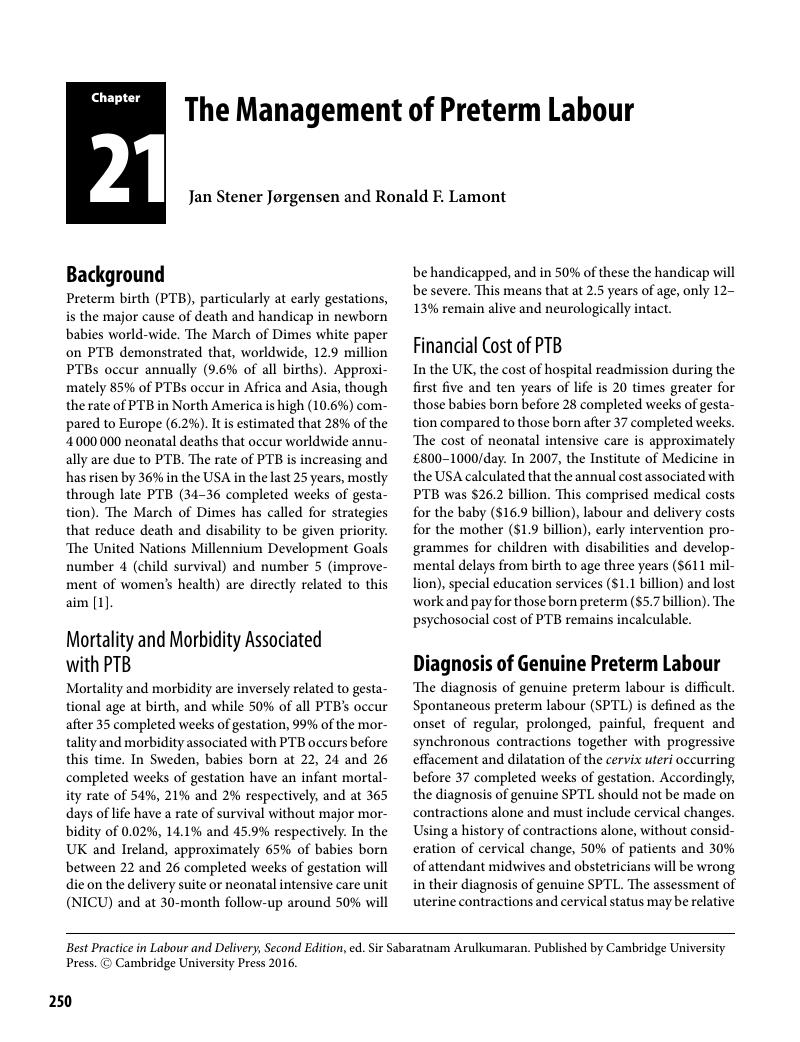Book contents
- Best Practice in Labour and DeliverySecond Edition
- Best Practice in Labour and Delivery
- Copyright page
- Dedication
- Contents
- Contributors
- Preface to the Second Edition
- Preface to the First Edition
- Book part
- Chapter 1 Pelvic and Fetal Cranial Anatomy and the Stages and Mechanism of Labour
- Chapter 2 The First Stage of Labour
- Chapter 3 Analgesia and Anaesthesia in Labour
- Chapter 4 Intrapartum Fetal Monitoring
- Chapter 5 Uterine Contractions
- Chapter 6 The Management of Intrapartum ‘Fetal Distress’
- Chapter 7 Nutrition and Hydration in Labour
- Chapter 8 Prolonged Second Stage of Labour Including Difficult Decision Making on Operative Vaginal Delivery and Caesarean Section
- Chapter 9 Instrumental Vaginal Deliveries
- Chapter 10 Caesarean Deliveries
- Chapter 11 Breech and Twin Delivery
- Chapter 12 Cord Prolapse and Shoulder Dystocia
- Chapter 13 Antepartum Haemorrhage
- Chapter 14 Management of the Third Stage of Labour
- Chapter 15 Postpartum Haemorrhage
- Chapter 16 Management of Morbidly Adherent Placenta
- Chapter 17 Acute Illness and Maternal Collapse in the Postpartum Period
- Chapter 18 Episiotomy and Obstetric Perineal Trauma
- Chapter 19 Induction of Labour
- Chapter 20 Preterm Prelabour Rupture of Membranes (pPROM)
- Chapter 21 The Management of Preterm Labour
- Chapter 22 Labour in Women with Medical Disorders
- Chapter 23 Management of Women with Previous Caesarean Section
- Chapter 24 Rupture of the Uterus
- Chapter 25 Management of Severe Pre-Eclampsia/Eclampsia
- Chapter 26 Neonatal Resuscitation and the Management of Immediate Neonatal Problems
- Chapter 27 The Immediate Puerperium
- Chapter 28 Triage and Prioritization in a Busy Labour Ward
- Chapter 29 Risk Management in Intrapartum Care
- Chapter 30 Team Working, Skills and Drills on the Labour Ward
- Chapter 31 Cerebral Palsy Arising from Events in Labour
- Chapter 32 Objective Structured Assessment of Technical Skills (OSATS) in Obstetrics
- Chapter 33 Non-Technical Skills to Improve Obstetric Practice
- Index
- References
Chapter 21 - The Management of Preterm Labour
Published online by Cambridge University Press: 27 January 2017
- Best Practice in Labour and DeliverySecond Edition
- Best Practice in Labour and Delivery
- Copyright page
- Dedication
- Contents
- Contributors
- Preface to the Second Edition
- Preface to the First Edition
- Book part
- Chapter 1 Pelvic and Fetal Cranial Anatomy and the Stages and Mechanism of Labour
- Chapter 2 The First Stage of Labour
- Chapter 3 Analgesia and Anaesthesia in Labour
- Chapter 4 Intrapartum Fetal Monitoring
- Chapter 5 Uterine Contractions
- Chapter 6 The Management of Intrapartum ‘Fetal Distress’
- Chapter 7 Nutrition and Hydration in Labour
- Chapter 8 Prolonged Second Stage of Labour Including Difficult Decision Making on Operative Vaginal Delivery and Caesarean Section
- Chapter 9 Instrumental Vaginal Deliveries
- Chapter 10 Caesarean Deliveries
- Chapter 11 Breech and Twin Delivery
- Chapter 12 Cord Prolapse and Shoulder Dystocia
- Chapter 13 Antepartum Haemorrhage
- Chapter 14 Management of the Third Stage of Labour
- Chapter 15 Postpartum Haemorrhage
- Chapter 16 Management of Morbidly Adherent Placenta
- Chapter 17 Acute Illness and Maternal Collapse in the Postpartum Period
- Chapter 18 Episiotomy and Obstetric Perineal Trauma
- Chapter 19 Induction of Labour
- Chapter 20 Preterm Prelabour Rupture of Membranes (pPROM)
- Chapter 21 The Management of Preterm Labour
- Chapter 22 Labour in Women with Medical Disorders
- Chapter 23 Management of Women with Previous Caesarean Section
- Chapter 24 Rupture of the Uterus
- Chapter 25 Management of Severe Pre-Eclampsia/Eclampsia
- Chapter 26 Neonatal Resuscitation and the Management of Immediate Neonatal Problems
- Chapter 27 The Immediate Puerperium
- Chapter 28 Triage and Prioritization in a Busy Labour Ward
- Chapter 29 Risk Management in Intrapartum Care
- Chapter 30 Team Working, Skills and Drills on the Labour Ward
- Chapter 31 Cerebral Palsy Arising from Events in Labour
- Chapter 32 Objective Structured Assessment of Technical Skills (OSATS) in Obstetrics
- Chapter 33 Non-Technical Skills to Improve Obstetric Practice
- Index
- References
Summary

- Type
- Chapter
- Information
- Best Practice in Labour and Delivery , pp. 250 - 263Publisher: Cambridge University PressPrint publication year: 2016



